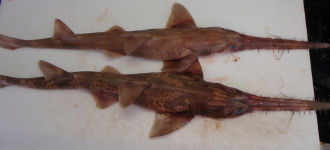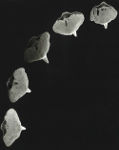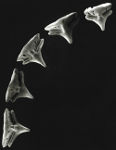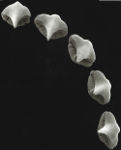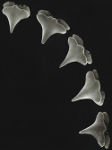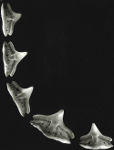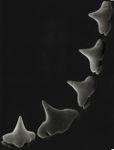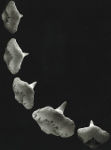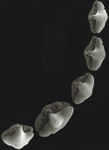Pristiophorus cirratus
(Latham, 1794)
Longnose sawshark
Classification: Elasmobranchii Pristiophoriformes Pristiophoridae
Reference of the original description
An essay on the various species of Sawfish. Transactions of the Linnean Society of London, 2, 273–282
An essay on the various species of Sawfish. Transactions of the Linnean Society of London, 2, 273–282
Image of the original description
.jpg)
Pristiophorus cirratus (Latham, 1794)
.jpg)
Pristiophorus cirratus (Latham, 1794)
Images of the original description (synonym)
No image in first description.
No image in first description.
Synonyms / new combinations and misspellings
Pristis anisodon, Pristis cirratus, Pristis cirrhata, Pristis cirrhatus, Squalus anisodon, Squalus tentaculatus
Pristis anisodon, Pristis cirratus, Pristis cirrhata, Pristis cirrhatus, Squalus anisodon, Squalus tentaculatus
Types
Pristiophorus cirratus
Holotype: BMNH: ?
Squalus anisodon
XXXX: No types known;
Squalus tentaculatus
XXXX: No types known;
Pristiophorus cirratus
Holotype: BMNH: ?
Squalus anisodon
XXXX: No types known;
Squalus tentaculatus
XXXX: No types known;
Description :
Citation: Pristiophorus cirratus (Latham, 1794): In: Database of modern sharks, rays and chimaeras, www.shark-references.com, World Wide Web electronic publication, Version 12/2025
Please send your images of "Pristiophorus cirratus" to info@shark-references.com
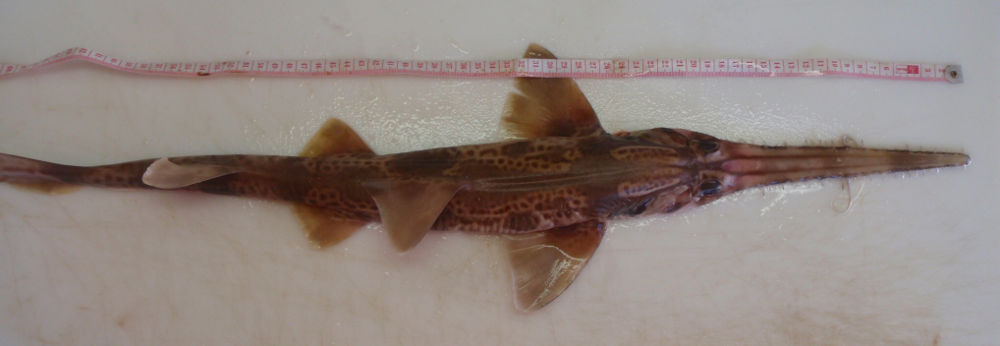
Pristiophorus cirratus (Latham, 1794), male, 95 cm TL, Victoria, Australia © Vincent Raoult, Marine Ecology Group, Biological Sciences, Macquarie University, Australia

Pristiophorus cirratus (Latham, 1794), male, 95 cm TL, Victoria, Australia © Vincent Raoult, Marine Ecology Group, Biological Sciences, Macquarie University, Australia
Common names
 Tiburón sierra trompudo,
Tiburón sierra trompudo,  Requin scie à long nez,
Requin scie à long nez,  Common sawshark,
Common sawshark,  Doggies,
Doggies,  Little sawshark,
Little sawshark,  Longnose saw shark,
Longnose saw shark,  Longnose sawshark,
Longnose sawshark,  Saw dog,
Saw dog,  Sawshark,
Sawshark,  Southern saw shark
Southern saw shark
 Tiburón sierra trompudo,
Tiburón sierra trompudo,  Requin scie à long nez,
Requin scie à long nez,  Common sawshark,
Common sawshark,  Doggies,
Doggies,  Little sawshark,
Little sawshark,  Longnose saw shark,
Longnose saw shark,  Longnose sawshark,
Longnose sawshark,  Saw dog,
Saw dog,  Sawshark,
Sawshark,  Southern saw shark
Southern saw shark
Short Description
Pristiophorus cirratus has a long, narrow, and narrowly tapering rostrum (rostrum length is 27-29% of TL), distance from rostral tip to barbels about equal or slightly greater than distance from barbels to mouth (1:1.2-1.3); distance from rostral barbels to nostrils slightly less or equal to distance from nostrils to 1st to 4th gill slits. About 9-10 large rostral teeth on each side of the rostrum in front of the barbels, 9 behind them; distance from mouth to nostrils 1.3-1.4 times internarial space. Tooth rows 39-49 in upper jaw. Dorsal and pectoral fins covered with denticles in large specimens. Lateral trunk denticles largely unicuspidate. First dorsal fin origin behind free rear tips of pectorals by eye length or more [518]. P. cirratus has a body pattern of dark blotches (mostly darker bands between pectoral fin bases, over gill slits, between spiracles and below dorsal fins) and spots (occasionally faint). Nostrils, almost circular, are situated about 2/3 way from barbels to corner or mouth, width at nostrils more than 4.5 in preoral snout in adults; preoral snout length more than 2.3 times distance from barbels to snout tip [1388]. Rostral teeth with dark margins; underside abruptly uniformly white [3538]. First dorsal fin origin behind free rear tips of pectorals by eye length or more [518]. Caudal fin almost straight, with slender upper and lower lobes; pectoral well developed but are not ray-like [1388].
Pristiophorus cirratus has a long, narrow, and narrowly tapering rostrum (rostrum length is 27-29% of TL), distance from rostral tip to barbels about equal or slightly greater than distance from barbels to mouth (1:1.2-1.3); distance from rostral barbels to nostrils slightly less or equal to distance from nostrils to 1st to 4th gill slits. About 9-10 large rostral teeth on each side of the rostrum in front of the barbels, 9 behind them; distance from mouth to nostrils 1.3-1.4 times internarial space. Tooth rows 39-49 in upper jaw. Dorsal and pectoral fins covered with denticles in large specimens. Lateral trunk denticles largely unicuspidate. First dorsal fin origin behind free rear tips of pectorals by eye length or more [518]. P. cirratus has a body pattern of dark blotches (mostly darker bands between pectoral fin bases, over gill slits, between spiracles and below dorsal fins) and spots (occasionally faint). Nostrils, almost circular, are situated about 2/3 way from barbels to corner or mouth, width at nostrils more than 4.5 in preoral snout in adults; preoral snout length more than 2.3 times distance from barbels to snout tip [1388]. Rostral teeth with dark margins; underside abruptly uniformly white [3538]. First dorsal fin origin behind free rear tips of pectorals by eye length or more [518]. Caudal fin almost straight, with slender upper and lower lobes; pectoral well developed but are not ray-like [1388].
Distribution
Eastern Indian Ocean: southern Australia [1388]. Does not occur in the Western Central Pacific [20050]. Source: www.gbif.org
Eastern Indian Ocean: southern Australia [1388]. Does not occur in the Western Central Pacific [20050]. Source: www.gbif.org
Human uses
fisheries: commercial
fisheries: commercial
Biology
Ovoviviparous, embryos feed solely on yolk [733]. Males mature at about 97 cm, born at about 38 cm [1388]. Common sawshark lives for more than 15 years. Mature females appear to breed every 1-2 years, carrying from 3-22 young, with about 10 being the average. After 12 months"quot; gestation, the pups are born in shallow coastal areas. They are about 11-14.5 in (27-37 cm) long at birth (Ref. 48640). Found on the continental shelf and upper slope. Feeds on small fishes, including cornet fishes (Fistularia), and crustaceans.
Ovoviviparous, embryos feed solely on yolk [733]. Males mature at about 97 cm, born at about 38 cm [1388]. Common sawshark lives for more than 15 years. Mature females appear to breed every 1-2 years, carrying from 3-22 young, with about 10 being the average. After 12 months"quot; gestation, the pups are born in shallow coastal areas. They are about 11-14.5 in (27-37 cm) long at birth (Ref. 48640). Found on the continental shelf and upper slope. Feeds on small fishes, including cornet fishes (Fistularia), and crustaceans.
Remarks
shark-references Species-ID=5014;
shark-references Species-ID=5014;
Parasites (arranged by Jürgen Pollerspöck)
Myxosporea
Monogenea
Cestoda
Trematoda
Copepoda
Myxosporea
Monogenea
Cestoda
- Acanthobothrium adlardi Campbell & Beveridge, 2002 [28858] [28741]
- Acanthobothrium robertsoni Campbell & Beveridge, 2002 [16128] [28858] [28741]
- Bibursibothrium gouldeni Mckenzie & Caira, 1998 [7622] [16929] [28858]
- Cardiobothrium beveridgei Mckenzie & Caira, 1998 [7622] [16929] [28858]
- Flexibothrium ruhnkei Mckenzie & Caira, 1998 [7622] [16929] [28858]
- Gilquinia robertsoni Beveridge, 1990 [16112] [28858]
- Grillotia pristiophori Beveridge & Campbell, 2001 [16251] [7376] [16112] [28858]
- Lacistorhynchus dollfusi Beveridge & Sakanari, 1987 [16253] [16112] [28858]
Trematoda
- Otodistomum pristiophori Johnston, 1902 [28858]
Copepoda








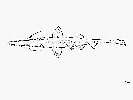
.jpg)
